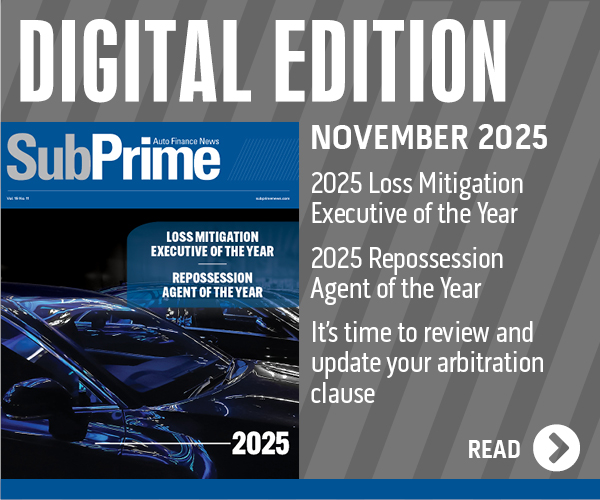Report: Franchised Dealers Spent $3.2B on Compliance in 2012

By subscribing, you agree to receive communications from Auto Remarketing and our partners in accordance with our Privacy Policy. We may share your information with select partners and sponsors who may contact you about their products and services. You may unsubscribe at any time.
WASHINGTON, D.C. –
Here are more numbers showing just how much of a bite regulatory compliance is taking out of franchised dealers’ profitability apple — especially for what it takes to legally operate the F&I office.
A new report released by the Center for Automotive Research on Friday showed U.S. franchised dealers spent $3.2 billion in 2012 to comply with 61 major federal rules, resulting in higher prices for dealership customers and the loss of an estimated 10,500 dealership jobs.
According to the report titled, “The Impact of Federal Regulations on Franchised Automobile Dealerships,” the average dealership incurred $182,754 in costs to comply with federal mandates governing employment, business operations, vehicle financing, sales, marketing and vehicle repair and maintenance. These regulatory costs equated to 21.7 percent of the average dealership’s pretax net profits — or about $2,400 per dealership employee.
The National Automobile Dealers Association commissioned the report produced by CAR, which is based in Ann Arbor, Mich. Analysts indicated cost estimates are for 2012 and are based on interviews in 2013 and 2014.
“The additional cost for new-car dealerships to comply with federal regulations are passed along to our customers in the form of higher prices, which results in lower vehicle sales and reduced employment at dealerships,” said Forrest McConnell, III, NADA chairman and a Honda/Acura dealer in Montgomery, Ala.
Drilling deeper into the report uncovered just how much F&I compliance is costing dealerships. Analysis of the mean values of compliance costs revealed that the dealership financial burden is greatest for the regulations included in the vehicle financing category, which includes items such as compliance with the Equal Credit Opportunity Act, the Fair Credit Reporting Act and the Truth in Lending Act.
Subscribe to Auto Remarketing to stay informed and stay ahead.
By subscribing, you agree to receive communications from Auto Remarketing and our partners in accordance with our Privacy Policy. We may share your information with select partners and sponsors who may contact you about their products and services. You may unsubscribe at any time.
In fact, more than 37 percent of that average cost increase stemmed from the necessities of compliance with federal rules involving the F&I office.
Report authors noted two of the eight dealers included in this study are part of a larger dealer group. The authors said interviewees at one of these dealerships were unable to identify some, and possibly a large share, of their regulatory compliance costs.
“Possibly due to this more centralized operations, the managerial staff was less knowledgeable about regulatory compliance costs than other interviewees,” the report said. “Researchers made a good faith effort to speak with corporate level management at the group to gain further insight into the dealerships costs, though these efforts were ultimately unsuccessful.”
For the second dealer that was part of a larger group, CAR researchers disaggregated composite data for the group and brought it to a single rooftop level. In this case, CAR worked with the dealer group to assess costs at a group level for the sake of efficiency and thoroughness.
“This method allowed the researchers to account for a greater portion of actual costs than would otherwise had been possible,” the report said. “The findings were then scaled using the number of group dealerships as a divisor. Therefore, descriptive statistics for this dealer profile are the mean findings for the larger enterprise.”
No matter how report authors had to tailor their analysis, they emphasized the final findings.
“It can be challenging for dealers to identify all costs associated with federal regulatory compliance. Some activities are spread among many facets of the business and accounting conventions do not support simple cost analysis. Other cost centers represent activities the dealers themselves admit they would do even if not regulated to do so,” the report said. “However, the data are clear that federal regulatory compliance costs are present and meaningful at all levels of the dealerships’ organizations.”
The selected dealerships included in the study represented a wide range of operations, including dealerships that sell domestic, Asian, and European brands at a variety of price points. Additionally, two of the dealerships had a body shop as certain regulations pertain only to those dealerships with body shop operations.
“During the interviews, the order of topics was randomized to prevent any biases, and interviewees were encouraged to substantiate cost estimates where appropriate. Interviewees were asked to use 2012 costs in their estimates,” the report said.
CAR determined the overall impact of these costs on the 2012 U.S. economy was estimated at $10.5 billion in lost economic output and more than 75,000 fewer jobs
Every $1 increase in a dealership’s regulatory compliance costs results in $3.28 in lost output in the U.S economy and a net loss of 44 cents to the U.S. Department of the Treasury, according to the report.
“The CAR report examined the costs incurred by new-car dealerships to comply with 61 federal regulations — a mere subset of all federal regulations with which new-car dealerships must comply,” report authors said.
“The study did not analyze the costs of upstream mandates imposed on vehicle manufacturers, such as fuel economy and safety rules. State and local regulatory mandates also were not analyzed. Thus, the study significantly underestimates the total regulatory burden imposed on dealerships,” they went on to say.
To download a copy of the report, click here.


